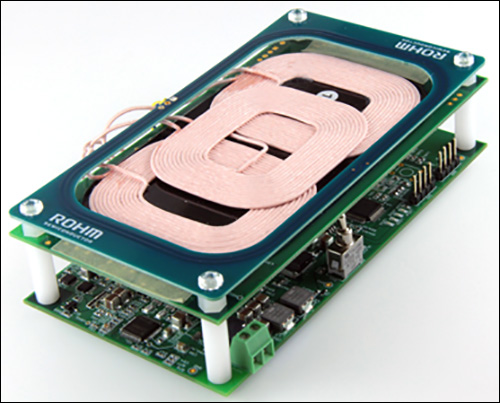Electronic components company ROHM is marketing its new wireless charging device, known as Qi+NFC, that employs Near Field Communication (NFC) reader integrated circuits (ICs) from STMicroelectronics (ST). The technology is built into its Qi-compliant automotive wireless charging reference design, the company reports, in order to prevent damage to NFC cards.
The evaluation board expects the solution to be ready this month, with commercial release of its new wireless charging IC slated for April. “So the new system, including our devices, will be [commercially] available by summer 2019,” says Kiyotaka Umemoto, the manager of ROHM’s Automotive Marketing Strategy Division.
The NFC-based charging module will include STMicroelectronics’ ST25R3914 NFC reader IC and 8-bit STM8AF microcontroller unit (MCU). In addition to protecting NFC cards from stray wireless charging transmissions, says Rene Wutte, STMicroelectronics’ marketing manager for NFC and RFID readers, “The NFC reader IC can be used for native pairing with Android [NFC-enabled] phones.”
Qi is an open interface standard designed for 15-watt wireless power transfer over the air, at a distance of approximately 1.6 inches. Most mobile device manufacturers are using the standard to provide wireless charging functionality in their new devices. In fact, wireless charging is becoming increasingly prevalent for mobile devices. According to research conducted by IHS Markit in 2015, consumer awareness of wireless charging doubled during the span of one year, to 76 percent, while shipments of wireless power receivers in mobile phone handsets reached more than 120 million units that year alone.
Most mobile handsets are currently built with wireless charging features. In conjunction with that trend, companies are providing more wireless charging spots, including automotive manufacturers. NFC devices are also commonly stored in the wallets, purses and pockets of individuals for payments, access control and more. NFC tags, however, can be damaged or destroyed by the magnetic fields of wireless chargers, creating a potential conflict for a variety of NFC technology products.
“NFC is now pulled into the automotive market from multiple sides,” Wutte explains. “On the one hand, the future of the key fob is the digital car key.” On the other, he says, “This step means increasing the security of the key, as well as the convenience of integrating the phone to the car system, allowing the consumer to simply tap their phone to pair with the infotainment system.” As such, Umemoto says, ROHM’s solution can protect NFC tags, as well as enabling pairing.
The Qi wireless charger’s NFC reader can detect whether an NFC card, key fob or other device is within range of the signal coming from the charger. Before sending a charging transmission, the NFC reader built into the charger transmits a 13.56 MHz signal complying with the ISO 14443 standard. If it receives a response from an NFC device, the system will not begin charging until the NFC card or device has been removed from the area.
In a car, that can mean the center console, where drivers often stash their devices while operating the vehicle. A driver might drop items, such as access-control key cards, wallets, credit cards and phones (the latter of which may store some NFC-based transportation or payment data in the handset). “All those NFC cards need to be protected against fatal damage,” Wutte says, “as recommended by WPC [the Wireless Power Consortium].”
With the Qi wireless charger, Wutte explains, “Manufacturers can ensure consumers’ NFC cards are protected from potential damage from the magnetic field emitted by the chargers because of the [STP25R3914] NFC reader inside the system.” But the NFC reader provides other benefits as well, he adds. “Manufacturers can also utilize NFC technology to enhance the user experience.”
For instance, manufacturers can leverage the STMicroelectronics NFC reader to transmit data to an NFC-integrated phone when it is placed on top of the Qi+NFC system. The solution can be configured so that once it detects a smartphone, it will identify that phone’s NFC-based ID number and automatically pair it with the car’s infotainment system. “This is much better than the user having to manually pair their device every time,” Umemoto states.
First and foremost, Umemoto says, the goal of the Qi standard is to eliminate what is known as battery anxiety. To accomplish this goal, the market needs a majority of battery-powered devices to be Qi-compatible, and for Qi chargers to be made available wherever people congregate, including in their homes and offices, as well as at restaurants and inside vehicles. “On the longer run,” he predicts, “wireless charging will be adopted to power laptops, drones and, perhaps, even electronic vehicles.”
This is not the first time the STMicroelectronics NFC reader has been used in a car, Wutte notes. In 2016, the company released its ST25R3914/15 IC, which is available in some car models as an option for key access via a mobile phone. “Now, since Qi chargers are required for 15-watt charging and there is a need to protect NFC cards against these stronger fields,” he says, “protection is becoming a mainstream feature, so we are involved in many projects.”


